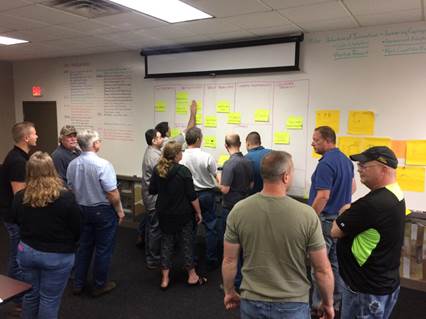Hack:
Neural Pathways to Innovation
Leaders who have an understanding of neuroscience basics have a tool much like a navigational compass to guide their teams and individuals through common change related obstacles. Neuroscience can help leaders improve innovation culture, increase innovation tool efficacy, and ultimately lead to successful business conversations and solutions.
Human physiology resists innovation. Though we humans have tremendous capacity to innovate, our instinct repels the very change process needed to achieve it. Habits are hard to break because we are naturally inclined to operate in a thoughtless ‘auto-pilot’ mode.
Our default position of routine arises because we subconsciously strive to conserve mental energy. In a process termed ‘neuroplasticity’, the more we activate any sequence of neurons the more we strengthen that particular active neural pathway. Over time, the more active pathway becomes our default processing route while other neuron routes become dormant. In other words, by our repetitious nature we eventually compromise our cognitive pliability, developing what we term ’muscle memory,’ ‘cognitive-bias,’ and ‘auto-pilot.’
Sometimes, we are even thrown into a cognitive disabling state of panic when we hear of impending change, (or that we must innovate). How our body reacts to the threat of a change, even when we realize change may be necessary, is a complex process involving tiny electrical signals and chemical hormones. When the most primitive part of our brain, (the amygdala), detects any perceived threat above a given threshold, an all-points bulletin alarm is sounded. Every part of us readies for attack. First comes Norepinephrine and Adrenaline, (the Emergency and Energy hormones), triggering our immediate ‘fight or flight’ response with a temporary increase in heart rate and energy level. Shortly thereafter, Cortisol, (the Stress hormone), is generated with a resulting decrease of non-critical functions such as skin temperature, reproductive drive, immunity, digestion, creativity, imagination, and complex thinking. One of the largest repercussions of Cortisol is its half-life in our bodies is perhaps 50-60 times longer than that of Oxytocin (the Trust hormone), or Dopamine (the Feel Good/Reward hormone). Stress lingers. When we hear bad news, it lasts much longer than the positive effects of any good news we receive.
Speed also plays an ‘auto-pilot’ role. Our non-conscious brain systems can process sensory information millions of times faster than our conscious (pre-frontal cortex) brain systems. ‘Auto-pilot’ gains us time and energy efficiencies, but it does NOT naturally navigate us toward cognitive variety. To be creative, have variety, and think innovatively takes more time and energy.
As an example, if a lion attacks us, yes, we are better positioned to survive. However, if our trigger is something a little less life threatening, (like our boss yelling at us, an unfamiliar group activity, or a problem at work requiring an innovative solution), unfortunately our non-conscious brain process still reacts the same way. Regardless of the emergency, once the physiological alarm is triggered our brain begins fueling our survival response. Energy is redirected from our cognitive processes into our physical ability to fight, or run.
So, ‘How Might We’: increase the sense of safety, reduce perception of threat, and allow the change process to happen more easily? ‘How Might We’ lead participants out of routines and into creation of new and improved innovative business solutions?
There ARE ways of navigating through physiological change related obstacles as we facilitate meetings and lead others to improve their capacity to innovate. Establishing and maintaining trust and reducing the perception of fear will: safely expand participant engagement, build intrinsic motivation and create valuable contributors to our innovation teams. We can challenge others to take cognitive risks within a safe environment without triggering a ‘flight or fight’ response.
In order to develop participant trust, we begin by making training sessions and innovation teams enjoyable. In the right environments, participants will produce Oxytocin and Dopamine instead of Cortisol. If our facilitation of innovation tools leads others out of ‘auto-pilot’, new and dormant neural pathways can be habituated, allowing new and different thinking.
Additionally, with repeated positive innovation experiences, participants can begin to develop their own intrinsically self-motivated new habits where they use innovation language, tools and methods when problem solving. This will happen when the participants non-consciously begin linking previous positive experiences to the increased pleasure they got at the time from the release of Dopamine and Oxytocin. Small early innovation successes can be built into larger systemic successes in this manner. A culture can be shifted with the help of neuroscience.
The environment in which we ask people to innovate can support a feeling of safety or can trigger a sense of threat. For example, when an innovation space is soft and comforting rather than austere and harsh, innovation participants are given an increased opportunity to remain in their neurological sweet spot, optimizing their creativity and effective cognitive solutions. A key ingredient to any well run idea generation session, (such as an "i-lab"), is the environmental space in which it occurs.
Additionally, our perspectives can be advantageously guided toward new possibilities and solutions within the construct of neuroscience. When we stare at a problem in just the right way through an ‘innovation lens,’ new neural pathways can be initiated. With use of these new neural pathways, our brain can begin interpreting the same information everyone else is looking at into a visualization of something different.
Everyone has an ability to innovate. It’s up to us as leaders to draw the best from our teams. Neuroscience is within our control and we should use it to our advantage to keep our participants in their sweet spots, above ‘auto-pilot’ level and below ‘fight or flight’ triggers.
This hack requires a dynamic ability to understand we are working with unique people each with unique physiologies. We can’t assume to know how others are thinking/feeling/engaging. As facilitators, we must be prepared. Yet we must also be amenable to tweaking facilitations on the fly to meet the perceived needs of the audience, rather than sticking to cookie cutter scripts.
Keeping training exercises fresh may also become a challenge after repeated trainings to the same participants. Having many innovation tools in our proverbial tool box and a cache of simple familiar elementary examples, (such as: babysitting, mowing lawns, dog walking etc.), will be helpful to facilitators. More challenging training sessions can come later after participants build trust. Initially teaching tools based around common and simple experiences keeps participants out of ‘flight or fight’ mode.
- Begin innovation sessions with an ice breaker or energizer. There are neuroscientific reasons for this:
- Target ‘safe’ and ‘fun’ to stay within their sweet spot.
- Get up out of seats and move around for energy.
- Disarm the threat response with laughter.
- Minimize the threat response within the body of the innovation session by having the group agree to conduct guidelines such as:
- There are no wrong answers.
- Language such as: ‘Yes / And,’ ‘How Might We,’ ‘What If,’ etc.
- Explain innovation tools first with familiar elementary examples, before moving onto more complex examples, and before finally addressing the problem at hand.
- Train with a combinations of tools, not just one tool. Keep a freshness factor activated to prevent participants from returning to their unchallenged ‘auto-pilot’ zone.
Facilitating the Tesla Model Business Model Canvas (BMC) in our innovation room.
Thanks to Matt Krathwohl, program director at Notre Dame’s CIMp; Jack Hiler, CEO of Accurate Castings, Inc.; and classmates Nancy Robie and ‘Jedi’ Jim Tusar. Also, Debra Raybold, That Essential Spark Inc., has been a tremendous resource for neuroscience leadership. And finally, many thanks to my wife Barb for being my rock during countless hours studying in this program.
This article was written as one of the requirements to obtain the Innovation Mentor Certification at CIMp. The CIMp program is part of iVia, The Way of Innovation TM, founded by The University of Notre Dame, Whirlpool Corporation, and Beacon Health System. Learn more at http://innovationcertification.nd.edu/
Accurate Castings http://www.hilerindustries.com/
That Essential Spark Inc. https://www.thatessentialspark.com
Thank you Earl for clearing up some of the chemistry and above triggers and reactions.
As far as the auto-mode and the back to comfort preferred reaction, I find it helping to check for what someone by the name of L.de Brabandere is defining as the second half of change and I call "The second click". First positive response being a step, but not frequently sustainable.
A different level for a second change is absolute need to get that final change.
Maybe a second change in chemicals in that one kind of elevation ?
- Log in to post comments
Hi Frederic,
Thank you for your comments, feedback, and letting me know about Luc de Brabandere's teachings. At first blush, he appears to be quite an insightful innovation philosopher. I'll have to research more of his wisdom. You're right maybe there's some neuroscience occurring if we can train ourselves to habituate positivity as a first response to disarm triggers. Later thought processes would be PFC related.
Appreciatively,
Earl
- Log in to post comments
Hi Earl, Thank you for writing this! This is a great reminder about the importance of the human factors of innovation and the critical importance of the culture we curate in our workplaces. I recall a TEDx talk on the topic of "Psychological Safety" by Amy Edmondston(https://www.youtube.com/watch?v=LhoLuui9gX8) that is a good build on this topic.
Be well!
DG4
- Log in to post comments
Hi DG4,
Great TED talk reference that marries excellently with the neuroscience in this article. Have already transformed some takeaways from it to build a pertinent conversation here about workplace psychological safety and how it so critically relates to the questioning, improvement and innovation processes. Thank you so much for the idea, and for the feedback.
Appreciatively,
EoI
- Log in to post comments







You need to register in order to submit a comment.